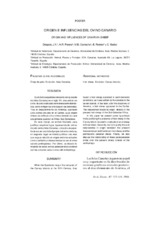Mostrar el registro sencillo del ítem
Origen e influencias del ovino canario
| dc.contributor.author | Camacho Vallejo, M.E. | |
| dc.contributor.author | Fresno Baquero, M.R. | |
| dc.contributor.author | Rodero Serrano, E. | |
| dc.contributor.author | Barba Capote, C.J. | |
| dc.contributor.author | Delgado-Bermejo, J.V. | |
| dc.date.accessioned | 2010-05-21T09:36:18Z | |
| dc.date.available | 2010-05-21T09:36:18Z | |
| dc.date.issued | 1998 | |
| dc.identifier.issn | 1885-4494 | |
| dc.identifier.uri | http://hdl.handle.net/10396/3406 | |
| dc.description.abstract | When the Spaniards begun the conquest of the Canary Islands at the XVth Century, they found a hair sheep exploited in semi-domestic conditions, as it was written by the cronists in the seven islands. A few later, after the discovery of America, a hair sheep appeared in the Caribe. The researchers locate its origin directly in the present hair sheep of the Sub-Saharian Africa. In this paper we present some hypothesis firstly justifying the presence of hair sheep in the Canary Island, located in a latitude of wool sheep in those times. Secondly, we try to justify the sure relationship in origin between the present Iberoamerican and Caribbean hair sheep and the prehispanic canarian sheep. Finally, we also discuss the relationship of these paleocanarian ovine over the present sheep breeds of the archipelago. | en |
| dc.description.abstract | Cuando los españoles inician la conquista de las Islas Canarias en el siglo XV, encuentran un ovino de pelo explotado de manera semi-doméstica, como reflejan los cronistas en las siete islas. Tras el descubrimiento de América, aparecen unos ovinos de pelo en el Caribe, cuyo origen directo se atribuye a los ovinos de este tipo que actualmente pueblan el Africa Sub-Sahariana. En este trabajo se emiten hipótesis para justificar, en primer lugar, la presencia de ovinos de pelo en las Islas Canarias, ubicados en aquella época en una latitud propia del ovino de lana; en segundo, lugar se intenta justificar una más que segura relación en origen entre los actuales ovinos caribeños e iberoamericanos con el ovino canario prehispánico. Por último, se discute la relación de estos ovinos paleocanarios tuvieron con las actuales razas ovinas del archipiélago. | es_ES |
| dc.format.mimetype | application/pdf | es_ES |
| dc.language.iso | spa | es_ES |
| dc.publisher | Universidad de Córdoba, Servicio de Publicaciones | es_ES |
| dc.rights | https://creativecommons.org/licenses/by-nc-nd/4.0/ | es_ES |
| dc.source | Archivos de Zootecnia 47 (178-179), 511-516 (1998) | es_ES |
| dc.subject | Ganado ovino | es_ES |
| dc.subject | Oveja de pelo | es_ES |
| dc.subject | Islas Canarias (España) | es_ES |
| dc.subject | Evolución | es_ES |
| dc.title | Origen e influencias del ovino canario | es_ES |
| dc.title.alternative | Origin and influences of canarian sheep | en |
| dc.type | info:eu-repo/semantics/article | es_ES |
| dc.relation.publisherversion | http://www.uco.es/organiza/servicios/publica/az/az.htm | es_ES |
| dc.rights.accessRights | info:eu-repo/semantics/openAccess | es_ES |

